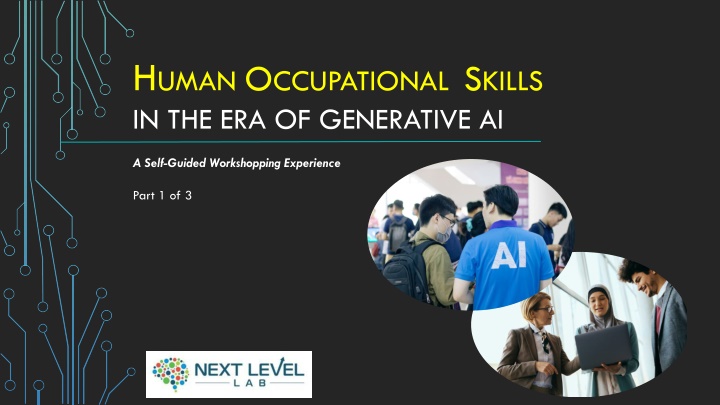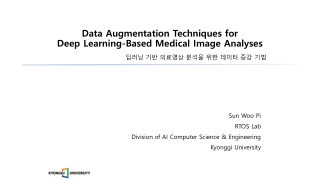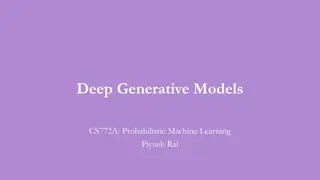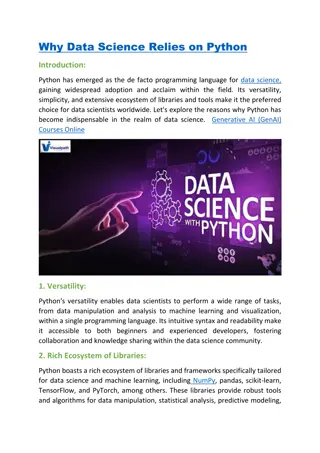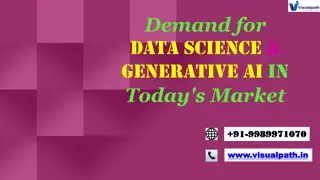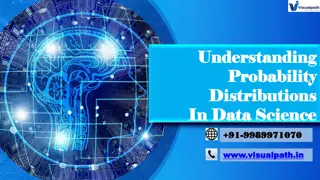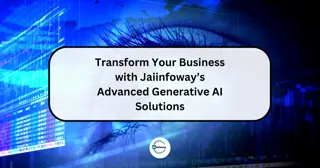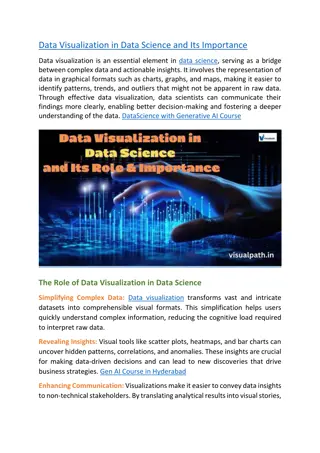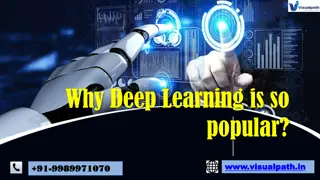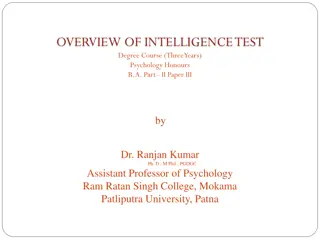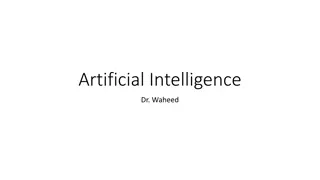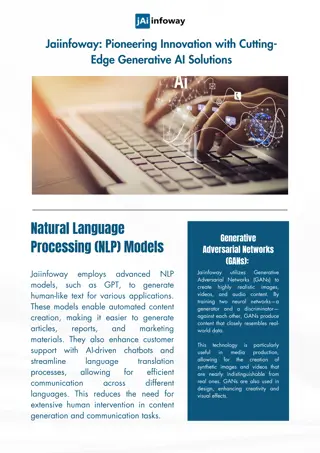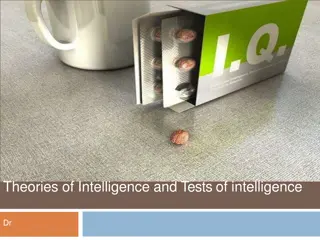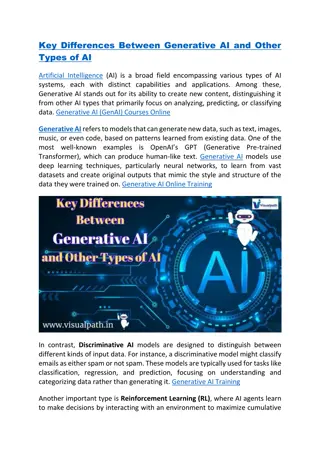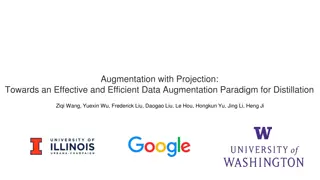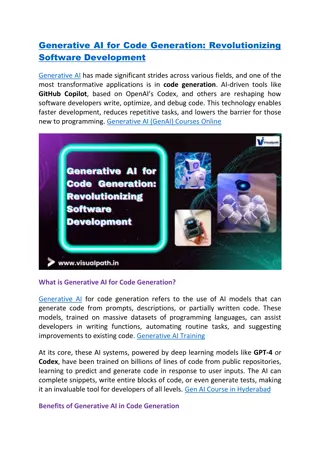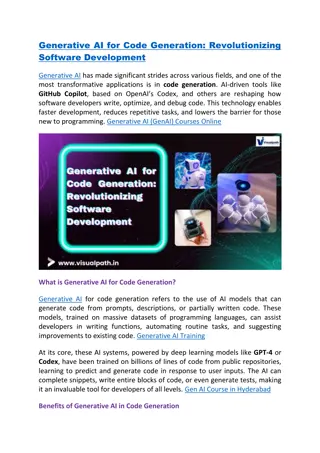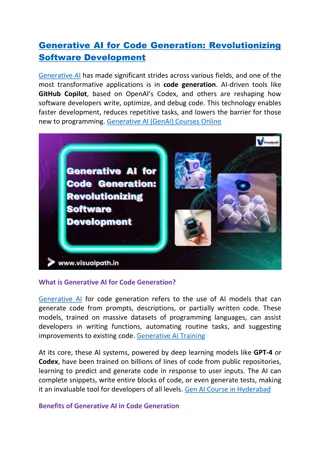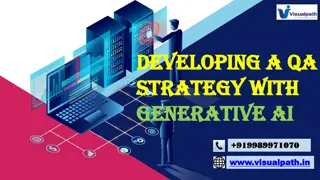Intelligence Augmentation in the Era of Generative AI
Generative artificial intelligence (AI) is shaping the future of human occupational skills. This workshop explores the synergy between humans and AI, highlighting intelligence augmentation and the evolving landscape of work and education. Join the conversation on the transformative potential of AI in learning and skill development.
Download Presentation

Please find below an Image/Link to download the presentation.
The content on the website is provided AS IS for your information and personal use only. It may not be sold, licensed, or shared on other websites without obtaining consent from the author.If you encounter any issues during the download, it is possible that the publisher has removed the file from their server.
You are allowed to download the files provided on this website for personal or commercial use, subject to the condition that they are used lawfully. All files are the property of their respective owners.
The content on the website is provided AS IS for your information and personal use only. It may not be sold, licensed, or shared on other websites without obtaining consent from the author.
E N D
Presentation Transcript
HUMAN OCCUPATIONAL SKILLS IN THE ERA OF GENERATIVE AI A Self-Guided Workshopping Experience Part 1 of 3
BACKGROUND Generative artificial intelligence (AI) has become one of the hottest topics in education and workforce development recently, as the likes of ChatGPT/GPT-4 and DALL-E disrupt existing systems in these spaces. While much of the discourse has revolved around the technology s human-like capabilities and the potential for substitution of skills such as writing and coding, more likely is a future where humans and AI will work together, enabling more effective performance than either humans or AI can do alone. We term the complementary relationship between humans and machines intelligence augmentation.
GOALS FOR THIS WORKSHOPPING EXPERIENCE 01 02 03 Expose learners to the complementary relationship between machines and learners, both in the educational system and in the workplace. Spur conversation about areas in which artificial intelligence (including generative AI), and in turn intelligence augmentation, may reshape human occupational skills and training efforts over the next decade. Encourage learners to think about how our educational institutions and organizations might support learners and employees in adapting to these changes.
PART 1 INTELLIGENCE AUGMENTATION
The following video featuring Dr. Chris Dede and Ashley Etemadi introduces the concept of intelligence augmentation and the complementary role between machine "reckoning" and human "judgment." As you watch, keep the following questions in mind: 1. How would you summarize intelligence augmentation in your own words? 2. What examples of judgment and reckoning come to mind for you? 3. Are there any uniquely human skills that you would add to the list? 4. What questions does this presentation raise about intelligence augmentation, generative AI in education/work, emerging technologies for learning, etc.? Dr. Chris Dede Senior Research Fellow, former Timothy E. Wirth Professor in Learning Technologies Ashley Etemadi Ed.M. Next Level Lab Research Assistant
CHECK FOR UNDERSTANDING WHAT IS YOUR DEFINITION OF "INTELLIGENCE AUGMENTATION?" Take 2 minutes to think about and write down your response.
REFLECTION Take 5 minutes to think about and write down your responses to the following three questions. What is something that resonated with me? What is something that surprised me? What is something that I want to learn more about?
REFLECTION: HYPOTHETICAL CASE A Lisa, a construction worker, entered the workforce in 2007-09. After completing an apprenticeship program, demand for her green services grew in the residential and industrial markets. The promise of lower costs, new home energy efficiency policies, and the association of green homes with healthier living all acted as catalysts for growth. A large part of Lisa's work has involved remodeling and refurbishment projects, from fitting water- efficient appliances, to installing roofs with solar panels. Gig work in construction, which puts a high premium on strong administration and management, has become even more prevalent in recent years. These skills and others, such as customer and personal service, are increasingly helpful for small businesses like Lisa's. Due to robust demand for green construction, labor shortages have emerged. To encourage entry into the field, Lisa has expanded apprenticeships. What might intelligence augmentation look like in the case of Lisa*? Take a few minutes to reflect on your own before viewing the example response on the next slide. *Excerpted from NESTA 2017
REFLECTION: HYPOTHETICAL CASE A What might intelligence augmentation look like in the case of Lisa*? Example response: Developed judgment skills would enable focusing on knowledge about the physical and cognitive requirements of construction work and cultural knowledge about preferences and patterns related to the environment and style of living. Lisa would apply her wisdom to socially champion increased investments in green technology and promote benefits to organizations that use sustainable practices. *Excerpted from NESTA 2017
REFLECTION: HYPOTHETICAL CASE B Mel, a restaurant owner from Manchester, has owned her own business and worked in catering for many years. While changing consumer needs have always impacted the industry, most recently shifts have shaped why and how people entertain. Consumers, especially millennials who are emerging as the dominant spenders, prioritize novel and engaging experiences in their spending preferences. Further, the home is becoming the increasingly predominant venue to entertain, and a greater number of on-demand services are now available through doorstep delivery. While Mel has used some of these services to sell her products, she has had to innovate and diversify what she offers to attract new customers. She has experience in the management and service orientation aspects of her work, but she lacks proficiency in other skills such as designing original and new in-demand experiences. What might intelligence augmentation look like in the case of Mel*? Take a few minutes to reflect on your own before viewing the example response on the next slide. *Excerpted from NESTA 2017
REFLECTION: HYPOTHETICAL CASE B What might intelligence augmentation look like in the case of Mel*? Example response: With developed judgment skills, Mel would draw more on her knowledge and background of sensory experiences with taste to understand and craft unique and enticing dishes and meals that meet customer demand. Mel would leverage her experience to forgo some initial profit to build a compelling reputation for social consciousness, fair dealing, and caring about her community. *Excerpted from NESTA 2017
PERSONAL CONNECTION Take 5 minutes to think about and write down your responses. What are some tasks you do on a daily or weekly basis that involve judgment (Embodied Experiential Knowing, Collective Cultural Knowing, and/or Personal Performative Knowing)? Now, what are some tasks that involve reckoning? How have you seen AI tools, such as generative AI, or other technologies play out in your workplace? How have you been interacting with these technologies? What capacities do those tools have? Where do you come into the equation? Have the tools changed what you bring to the table, and if so, how?
TO CONTINUE, ACCESS PART 2 For any questions or comments, or if you are interested in partnering on this work, please contact: Dr. Chris Dede, Harvard Graduate School of Education chris_dede@gse.harvard.edu
